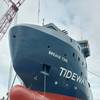Study: Offshore Ambient Vibration Monitoring
SUNY Maritime research team studies ambient vibration monitoring of offshore equipment
Two State University of New York (SUNY) Maritime College professors have received a $65,000 grant from the American Bureau of Shipping (ABS) to develop a program for inspecting underwater drilling equipment and gathering and maintaining information about its structural well being, all while the equipment remains in service and fully operational.
Dr. Daniel Fridline, Assistant Professor, Mechanical Engineering and Dr. Neveen Shlayan, Assistant Professor, Electrical Engineering, along with 10 undergraduate research assistants, are developing a periodic or continuous survey and inspection method using ambient vibration monitoring while the physical asset (e.g., drill ships or drill rigs) still is operational. It is hoped that the survey can provide information about the equipment’s current state of structural health, establish a baseline survey, and provide information on specific locations where more detailed inspection is required.
ABS has funded the two-phase study by Drs. Fridline and Shlayan with $22,209 in December 2013, and an additional $42,906 this past August.
Drs. Fridline and Shlayan recently had the opportunity to meet and discuss their research with ABS Chairman and Chief Executive Officer, Christopher J. Wiernicki, when he visited the SUNY Maritime College campus last month.
Phase I
From an operational and economic standpoint, the necessity to remove assets from service to facilitate detailed integrity inspections becomes prohibitive. As such, there is a strong desire to reduce or eliminate the need for taking assets out of service for survey and inspection.
A program of periodic or continuous survey and inspection methods such as ambient vibration monitoring, while the asset is still operational, can provide information about the current state of structural health based on an initial baseline survey. In addition, the monitoring information can be coupled to advanced numerical models (e.g., finite element methods) to identify locations where a more detailed, human survey or inspection, is required.
The Phase I proposal is for a preliminary investigation and survey of existing monitoring techniques that could be applied to offshore structures. A numerical (finite element) model of a typical offshore platform will be developed and used as a tool toward the identification of vibration characteristics of the structure. The model will be used as a tool for decisions regarding suitable sensor systems (discrete accelerometers, fiber optic networks) for deployment on a future add-on proposal.
During Phase I, three Mechanical Engineering program and one Electrical Engineering program undergraduate students worked on the project as part of an undergraduate research course. During the course of Phase I, the student research assistants were instrumental in researching the current state of technology in the space of sensors, sensor systems, and wireless sensing networks; and developing baseline structural dynamic models of typical offshore systems (e.g., a wind turbine tower and a semi-submersible drill rig). At the completion of the Phase I project, they successfully delivered a summary report of their findings to ABS, which enabled the acquisition of Phase II funding.
Phase II
This phase’s proposal is for the further development of algorithms for dynamic system parameter estimation, damage detection, and optimal sensor placement. These algorithms will be tested using a full-scale prototype, which will be an actual, readily-available, and accessible marine structure (e.g., mooring dolphin). Mathematical modeling and finite element modeling will be used as tools for determining system parameters and the identification of damage states.
Two senior class Mechanical Engineering students, who are enrolled in Dr. Fridline’s Vibrations class, are learning the theory behind the work being performed during Phase II of the project. Their project participation will allow them to gain an increased knowledge of the field of vibration analysis, as applied to marine and offshore structures.
Four Electrical Engineer program students currently are working on the Phase II proposal as part of an independent study. They are tasked with developing a wireless sensing network with a data acquisition system for structural health monitoring. The research assistance also are working on a prototype of individual units that will eventually be networked, as well as the development of algorithms to optimize the number and location of sensors for any offshore structures. These tasks requires the students to learn advanced control theory, programming skills, embedded electronics, databases, as well as reading and writing academic papers.
Ambient Vibration Monitoring
Measurement and analysis methods based on the dynamic characteristics of a structure provides a rapid, non-invasive and cost effective method for the diagnosis of existing structural conditions and enables the asset owner or municipality to make informed decisions about maintenance actions.
The basis for dynamic-based methods lies in the idea that every structure has a typical dynamic behavior termed the vibrational signature. Any changes in a structure, such as damage leading to a decrease in its load-carrying capacity, have an impact on the dynamic response of the structure. Measurement and analysis of the dynamic response characteristic of a structure enables the evaluation of quality and structural integrity and makes it possible to obtain knowledge of the current operational conditions.
During the past 15 years, dynamic characteristic monitoring systems have been developed and successfully deployed on engineering structures such as wind towers, cooling towers, bridges, buildings, dams, chimneys, and roadway structures, independent of construction methods and material systems. A major advantage of these methods is the non-invasive application of the technology, which allows for monitoring of situations where visual inspection is difficult, or impossible. Combined with traditional inspection methods, the information provided by dynamic methods allows for an accurate condition assessment and remaining lifetime prediction.













